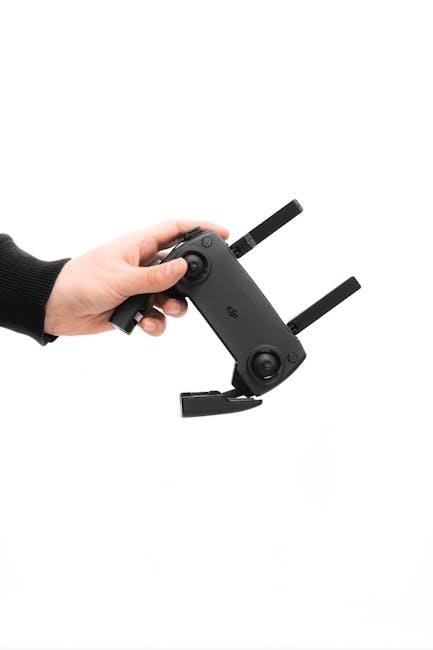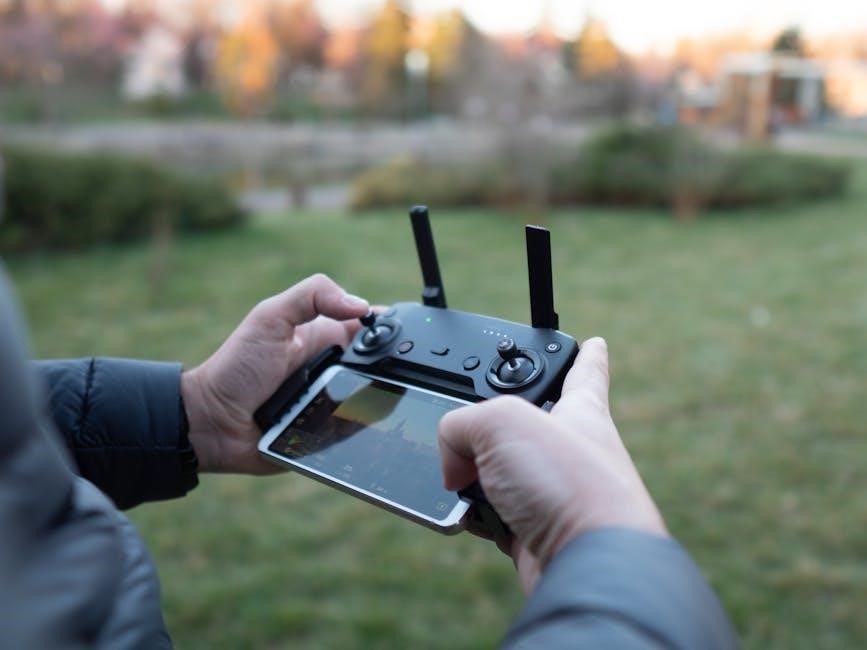Welcome to the PECO Thermostat user manual. This guide introduces the T8532-001 model, designed to regulate temperature efficiently. Learn about its programmable features and energy-saving capabilities.
1.1 Overview of the PECO Thermostat
The PECO Thermostat, model T8532-001, is a programmable device designed to regulate temperature efficiently. It supports features like temperature hold and energy-saving modes, ensuring optimal comfort and energy efficiency. Compatible with various HVAC systems, including heat pumps, this thermostat offers flexible scheduling options. The user manual provides detailed instructions for installation, wiring, and operation. Models such as T180, TA180, and TB180 are highlighted for their advanced controls and programmable capabilities. The thermostat is designed to work with systems requiring precise temperature management, making it suitable for both residential and light commercial use. This guide will help users navigate its features and settings effectively.
1.2 Importance of the User Manual
The user manual is essential for maximizing the PECO Thermostat’s performance. It provides step-by-step instructions for installation, programming, and troubleshooting. By following the manual, users can prevent common issues, avoid costly callbacks, and ensure proper operation. The guide covers key features like scheduling, temperature hold, and energy-saving modes, helping users optimize comfort and efficiency. Detailed wiring diagrams and technical specifications are included to assist with setup. The manual also addresses safety precautions and maintenance tips, ensuring the thermostat operates safely and effectively. Referencing the manual is crucial for understanding advanced settings and customizing the thermostat to meet specific needs.

Product Features and Specifications
The PECO Thermostat (models like T8532-001 and TA155-018) offers programmable scheduling, energy-saving modes, and smart home integration. It operates at 24-277VAC, ensuring efficient temperature control and compatibility with various systems.
2.1 Key Features of the PECO Thermostat
The PECO Thermostat, such as model T8532-001, features programmable scheduling, temperature hold functionality, and smart home integration. It supports
both heating and cooling systems, with a wide voltage range of 24-277VAC. The thermostat is designed for energy efficiency, offering
customizable settings to optimize comfort and reduce energy consumption. Additionally, it provides remote access through smart home platforms,
allowing users to control settings from anywhere. These features make it a versatile and user-friendly solution for modern HVAC systems.
2.2 Technical Specifications
The PECO Thermostat models, such as the T8532-001, operate within a voltage range of 24-277VAC, ensuring compatibility with various HVAC systems. They support
both heating and cooling systems, with specific models offering changeover functionality. The thermostat features programmable temperature settings,
with control ranges suitable for oil injection systems (ON at 100°C and OFF at 90°C). The NPBC-V3M electronic pellet burner controller
includes 16 outputs for mechanism control. Certain models, like the TA155-018, are designed for Heat/Cool systems without requiring a switch.
These specifications ensure reliable performance and adaptability to different heating and cooling configurations, making the PECO Thermostat a robust
choice for diverse applications.

Installation and Wiring
- Ensure power is turned off before starting installation.
- Verify wiring compatibility with your HVAC system.
- Follow step-by-step wiring instructions for safe setup.
- Check existing wiring for damage or wear.
3.1 Pre-Installation Checks
Before installing your PECO thermostat, ensure the following steps are completed:
- Turn off the power to your HVAC system at the circuit breaker or fuse box to avoid electrical hazards.
- Verify that your HVAC system is compatible with the PECO thermostat by checking its voltage and wiring requirements.
- Inspect the existing wiring for any signs of damage or wear, such as frayed wires or loose connections.
- Determine the type of system you have (e.g., heating only, cooling only, or both) to configure the thermostat correctly.
- Gather all necessary tools and materials, such as a screwdriver, wire strippers, and the thermostat mounting hardware.
- Read through the manual to understand the installation process and ensure you have internet access for smart features.
These checks ensure a smooth and safe installation process.
3.2 Wiring Diagrams and Connections
Refer to the provided wiring diagram in the manual to ensure proper connections for your PECO thermostat. Start by identifying the terminal labels (e.g., R, W, Y, G, C) on your HVAC system and thermostat. Match the wires to their corresponding terminals, ensuring secure connections to avoid malfunctions. Use the wire labels provided in the kit to keep track of each wire during installation. Connect the R (red) wire to the R terminal, and the W (white) wire to the W terminal for heating. The Y (yellow) wire connects to the Y terminal for cooling, while the G (green) wire connects to the G terminal for fan control. If your system requires a common wire, connect the C (blue) wire to the C terminal. Double-check all connections before restoring power to the system. Proper wiring ensures optimal performance and safety. If unsure, consult a licensed electrician. Correct connections are essential for the thermostat to function accurately and efficiently.
3.3 Mounting the Thermostat
MOUNT the PECO thermostat in a location with consistent temperature reading, avoiding direct sunlight or drafts. Ensure the surface is level and sturdy. Use the provided wall anchors or screws to secure the thermostat baseplate to the wall. If drilling into drywall, insert wall anchors to prevent damage. Align the baseplate with the wiring connections, ensuring it is straight and level. Once the baseplate is securely fastened, gently snap the thermostat onto it until it clicks into place. Make sure all wires are neatly connected and not pinched. For concrete or brick walls, use appropriate screws or anchors. Follow the manufacturer’s instructions for the backplate installation to ensure stability. Proper mounting ensures accurate temperature sensing and control.

Operating the PECO Thermostat
OPERATE the PECO thermostat using its intuitive interface. Adjust temperature, switch modes, and access settings with ease. Ensure smooth functionality for optimal comfort and energy efficiency.
4.1 Basic Controls and Navigation
The PECO thermostat features an intuitive interface designed for easy operation. The touchscreen display allows users to adjust temperatures, toggle between modes, and access settings seamlessly. Use the arrows to increase or decrease the temperature, and select modes like Heat, Cool, or Off. The menu button provides access to additional settings, such as fan controls and system preferences. Navigate through options by swiping or tapping on the screen. The thermostat also includes a back button to return to the previous screen and an exit option to close the menu without saving changes. These controls ensure straightforward navigation, making it simple for users to manage their comfort settings efficiently.
4.2 Setting Up a Schedule
To optimize energy usage and comfort, the PECO thermostat allows you to create a custom schedule. Access the scheduling feature by navigating to the menu and selecting “Schedule Settings.” Choose the day(s) you want to program and set the time and desired temperature for each period. For example, set a lower temperature when you’re asleep or away from home. Once programmed, save your settings to activate the schedule. The thermostat will automatically adjust the temperature according to your preferences. You can also modify the schedule at any time by revisiting the menu. This feature ensures your home stays comfortable while reducing energy waste when you’re not around.
4.3 Using the Temperature Hold Feature
The PECO thermostat’s Temperature Hold feature allows you to lock the current temperature setting, ensuring it remains unchanged. This is ideal for maintaining a consistent environment without accidental adjustments. To activate the hold, navigate to the menu, select “Temperature Hold,” and confirm your choice. The thermostat will display a hold indicator, confirming the feature is active. To deactivate, repeat the process and select “Cancel Hold.” This feature is useful for scenarios like parties or special events, where you want to maintain a specific temperature for an extended period. It provides peace of mind and helps prevent unintended temperature changes, ensuring your home remains comfortable as desired.

Advanced Features
The PECO thermostat offers advanced features like remote access via smartphone apps, energy-saving modes, and customizable settings to optimize comfort and efficiency. These features enhance user experience.
5.1 Remote Access and Smart Home Integration
The PECO thermostat supports remote access through its smartphone app, allowing users to adjust settings, monitor energy usage, and receive notifications from anywhere. It integrates seamlessly with popular smart home systems like Amazon Alexa and Google Assistant, enabling voice control and enhanced automation. This feature ensures convenience and energy efficiency by enabling users to manage their thermostat without physical interaction. The app also provides detailed insights into heating and cooling patterns, helping users optimize their settings for better comfort and savings. By connecting to smart home ecosystems, the PECO thermostat offers a modern, streamlined experience tailored to smart living.
5.2 Energy-Saving Modes
The PECO thermostat offers multiple energy-saving modes designed to reduce energy consumption and lower utility bills. The Eco Mode automatically adjusts temperatures to use less energy when the home is unoccupied or during off-peak hours. Smart Mode learns the user’s schedule and preferences to optimize heating and cooling, ensuring energy is used efficiently. Additionally, the thermostat features a programmable energy-saving schedule, allowing users to set specific temperature ranges for different times of the day. These modes work together to minimize energy waste while maintaining comfort. By utilizing these features, users can achieve significant savings on their energy costs without compromising on performance or convenience.
5.3 Customizable Settings
The PECO thermostat offers a variety of customizable settings to tailor your heating and cooling experience. Users can adjust temperature ranges, set custom schedules, and personalize comfort levels to suit their preferences. Advanced settings include geofencing, which adjusts the temperature based on your location, and smart home integrations for seamless control. Additionally, you can customize notifications to stay informed about system updates, temperature changes, and energy usage. These features allow for a more personalized and efficient use of the thermostat, ensuring optimal comfort and energy savings. By customizing these settings, users can create a system that perfectly aligns with their lifestyle and needs.

Maintenance and Troubleshooting
Regular maintenance ensures optimal performance and longevity of your PECO thermostat. Clean the display, check wiring, and update software. Troubleshoot common issues like connectivity or temperature inaccuracies.
- Clean the thermostat display gently with a soft cloth.
- Inspect wiring connections for damage or corrosion.
- Restart the device to resolve temporary glitches.
6.1 Regular Maintenance Tips
Regular maintenance is essential to ensure your PECO thermostat operates efficiently. Start by cleaning the device with a soft cloth to remove dust and debris. Inspect wiring connections for damage or corrosion and tighten them if necessary. For battery-powered models, replace batteries annually or when the low-battery indicator appears. Update the thermostat’s software periodically to access new features and improvements. Check the temperature calibration to ensure accuracy and refer to the user manual for specific calibration instructions. Finally, review the device’s settings to confirm they align with your comfort and energy-saving preferences. Regular upkeep prevents malfunctions and extends the thermostat’s lifespan.
- Clean the thermostat with a soft, dry cloth.
- Inspect and tighten wiring connections.
- Replace batteries as needed;
- Update software for optimal performance.
6.2 Common Issues and Solutions
Troubleshooting your PECO thermostat can resolve many common issues. If the thermostat doesn’t turn on, check the power source or circuit breaker. For incorrect temperature readings, ensure proper calibration and verify that the sensor is clean. If the screen is unresponsive, restart the device or replace the batteries. Connectivity issues with Wi-Fi or smart home systems can often be resolved by resetting the thermostat or updating its software. Consult the user manual for detailed reset instructions. Addressing these problems promptly ensures consistent performance and comfort. Always refer to the troubleshooting guide in the manual for step-by-step solutions.
- Check power source if the thermostat doesn’t turn on.
- Calibrate the sensor for accurate temperature readings.
- Restart or replace batteries for an unresponsive screen.
- Reset or update software for connectivity issues.
6.3 Resetting the Thermostat
Resetting your PECO thermostat can resolve persistent issues or restore factory settings. To reset, navigate to the menu settings and select the “Reset” option. Follow the on-screen instructions to complete the process. For a factory reset, press and hold the “Menu” and “Down” buttons simultaneously for 10 seconds. This will erase all custom settings, so you’ll need to reconfigure your preferences. If the thermostat is unresponsive, disconnect it from power for 30 seconds before reconnecting. After resetting, ensure the device is recalibrated for accurate performance. Refer to the user manual for detailed reset procedures. Resetting should only be done when other troubleshooting steps fail.
- Navigate to the menu and select the “Reset” option.
- Press and hold “Menu” and “Down” for a factory reset.
- Disconnect power for 30 seconds if unresponsive.
- Reconfigure settings after resetting.


Safety Guidelines
Always follow safety precautions to avoid accidents. Keep the thermostat away from water and extreme temperatures. Ensure proper installation and handling by qualified personnel only. Regularly inspect wiring and connections to prevent hazards. In case of malfunction, disconnect power immediately and contact technical support. Never attempt repairs without proper training. Adhere to all safety standards and manufacturer instructions for optimal safety and performance.
- Avoid exposing the thermostat to water or moisture.
- Ensure proper installation by a certified technician.
- Regularly inspect wiring for damage or wear.
- Disconnect power before performing any maintenance.
7.1 Safety Precautions
Ensure safe operation by following essential precautions. Avoid exposing the thermostat to water or extreme temperatures, as this can damage the device or pose electrical risks. Keep it out of reach of children and pets to prevent accidental tampering. Always disconnect power before performing any maintenance or repairs. Use only approved replacement parts to maintain safety and functionality. Never attempt to disassemble the thermostat unless instructed by a professional. Follow all local electrical codes and regulations during installation. Regular inspections of wiring and connections are crucial to prevent hazards. In case of malfunctions, turn off the power and contact a certified technician immediately;
- Keep the thermostat away from water and moisture.
- Disconnect power before servicing or repairing.
- Use only manufacturer-recommended replacement parts.
- Avoid disassembling the device without professional guidance.
- Regularly inspect wiring for damage or wear.
7;2 Emergency Procedures
In case of an emergency, follow these steps to ensure safety and minimize damage. If the thermostat malfunctions or causes system issues, switch off the power at the circuit breaker. For extreme temperature fluctuations, manually adjust your HVAC system to maintain comfort. If you suspect a gas leak or carbon monoxide issue, evacuate the premises and contact emergency services immediately. Never attempt to repair the thermostat yourself in an emergency. Instead, disconnect power and contact a certified technician. Keep emergency contact numbers handy for quick assistance.
- Switch off power at the circuit breaker if the thermostat malfunctions.
- Manually control your HVAC system during temperature extremes.
- Evacuate and call emergency services if a gas leak is suspected.
- Contact a certified technician for professional assistance.

Optimizing Performance
Regularly update schedules and adjust temperature settings to match your lifestyle. Ensure proper system maintenance and clean filters for optimal efficiency. Use energy-saving modes to reduce consumption while maintaining comfort. Adjust settings seasonally to align with weather patterns. Monitor performance reports to identify energy-saving opportunities. Ensure the thermostat is calibrated correctly for accurate temperature control. By following these steps, you can maximize the thermostat’s performance and enjoy consistent comfort while lowering energy bills.
- Update schedules to align with your daily routine.
- Clean or replace filters for better airflow and efficiency.
- Utilize energy-saving modes to reduce consumption.
- Calibrate the thermostat for accurate temperature control.
- Analyze performance reports to optimize settings.
8.1 Energy Efficiency Tips
Maximizing energy efficiency with your PECO thermostat involves strategic temperature adjustments and smart scheduling; Lower the temperature by 1-2 degrees in winter and raise it by the same in summer to reduce energy use. Use the programmable schedule to align temperature settings with your daily routines, avoiding unnecessary heating or cooling when no one is home. Enable geofencing to automatically adjust temperatures based on your location. Consider setting a higher temperature when cooling and a lower temperature when heating to optimize efficiency. Additionally, use the energy usage reports to identify patterns and make data-driven adjustments. Regularly cleaning filters and ensuring proper system maintenance also enhances efficiency. By implementing these tips, you can significantly lower energy consumption while maintaining comfort.
- Adjust temperatures by 1-2 degrees for seasonal efficiency.
- Program schedules to match your daily activities.
- Enable geofencing for location-based temperature control;
- Use energy reports to monitor and optimize usage.
- Regularly clean or replace filters for better performance.
8.2 Adjusting Settings for Optimal Comfort
For optimal comfort, tailor your PECO thermostat settings to your lifestyle and preferences. Start by setting your preferred temperature range, balancing comfort and energy efficiency. Adjust the humidity levels to maintain a cozy environment, especially in extreme weather. Utilize the fan settings to circulate air effectively without overcooling or overheating. Experiment with different temperature holds to maintain a consistent feel. Leverage the smart features to learn your habits and adapt settings automatically. Regularly test and refine your adjustments to ensure the system performs optimally in your home. Small tweaks can make a significant difference in comfort and overall satisfaction.
- Set a preferred temperature range for comfort.
- Adjust humidity levels seasonally.
- Use fan settings for efficient air circulation.
- Experiment with temperature holds.
- Refine settings based on performance and comfort.

Frequently Asked Questions
Explore common queries about the PECO thermostat, including installation, features, and troubleshooting, to ensure smooth operation and optimal performance of your device.
- How do I reset the thermostat?
- Why is my thermostat not responding?
- Can I control it remotely?
- How do I set a schedule?
9.1 General Inquiries
Address common questions about the PECO thermostat, such as compatibility, basic functionality, and initial setup. These inquiries help users understand the thermostat’s capabilities and operation.
- Is the PECO thermostat compatible with my HVAC system?
- How do I change the temperature scale from Celsius to Fahrenheit?
- Can I control the thermostat without a smartphone app?
- Does the PECO thermostat require a C-wire for installation?
- How do I update the thermostat’s software?
These general inquiries provide foundational knowledge for users to operate and maintain their PECO thermostat effectively.
9.2 Technical Support and Assistance
For technical issues or advanced troubleshooting, PECO thermostat users can access dedicated support channels. Contact the support team via phone, email, or live chat for personalized assistance.
- Visit the official PECO website for a comprehensive support center.
- Download the latest user manual or firmware updates.
- Explore the FAQ section for quick solutions to common problems.
- Engage with community forums for peer-to-peer advice.
- Request remote diagnostic support for complex issues.
PECO’s technical support ensures users receive timely and effective solutions to maintain optimal thermostat performance.
The PECO thermostat user manual provides comprehensive guidance for optimal performance and energy efficiency. By following the instructions, users can enjoy enhanced comfort and smart temperature control.
10.1 Final Thoughts
The PECO thermostat user manual serves as a valuable resource, guiding users through installation, operation, and customization. With its intuitive design and smart features, the thermostat simplifies temperature control while enhancing energy efficiency. By adhering to the manual’s instructions, users can maximize comfort and reduce energy consumption. The comprehensive guide ensures that even novice users can navigate advanced settings effortlessly. This concludes the manual, providing a solid foundation for users to enjoy the full benefits of their PECO thermostat.
10.2 Next Steps
Now that you’ve completed the PECO thermostat user manual, it’s time to explore its features and optimize your setup. Start by experimenting with advanced settings like energy-saving modes and customizable options to tailor the thermostat to your preferences. Ensure your device is registered with the manufacturer for updates and support. Regularly check for software updates to maintain optimal performance. Explore additional resources or guides for troubleshooting or advanced configurations. If you encounter any issues, refer to the troubleshooting section or contact customer support. By following these steps, you’ll maximize the efficiency and comfort provided by your PECO thermostat.
